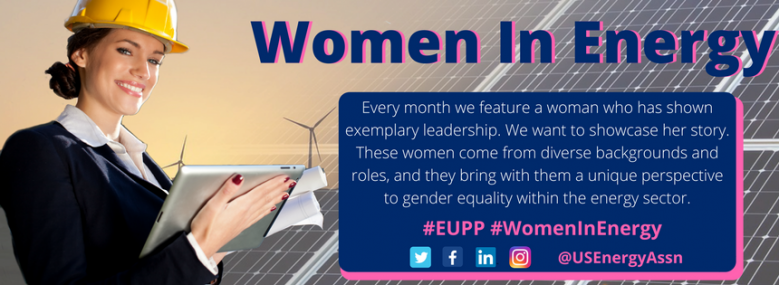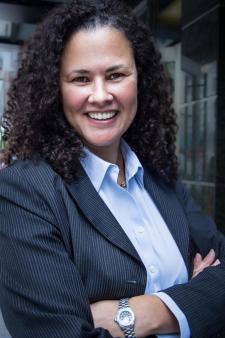
Women In Energy: Kelly Speakes-Backman
The Women in Energy series is a joint project between USEA and USAID that was developed out of USEA’s Engendering Utilities Partnership, a program funded by USAID to improve gender policies and gender outcomes at their respective organizations.

Every month we feature a woman who has shown exemplary leadership. We want to showcase your story this month. The women among you come from diverse backgrounds and roles, and they bring with them a unique perspective to gender equality within the energy sector.

Kelly Speakes-Backman is the first CEO of the Energy Storage Association. Kelly has spent over 20 years working in energy and environmental issues in the public, NGO and private sectors, including United Technologies, SunEdison and Alliance to Save Energy. She is a former Commissioner of the Maryland Public Service Commission where she also served as Chair of the Board of Directors of the Regional Greenhouse Gas Initiative, co-vice chair of the NARUC Committee on Energy Resources and the Environment, and member of the EPRI Energy Efficiency & Grid Modernization Public Advisory Group. She serves on the Board of Directors at the Northeast Energy Efficiency Partnerships (NEEP) and on the External Advisory Board of Georgia Institute of Technology’s Strategic Energy Institute. In 2019, Kelly was named The Cleanie Awards® Woman of the Year.
*USEA does not alter the substance of the responses from the women featured. The answers are their own.
Women in Energy Interview Questions
How have your education and career path led you to where you are now?
"I studied mechanical engineering and have always had an affinity for new technologies to improve lives. But I didn’t necessarily enjoy being a design engineer, after having done that as my first job out of college. So, it’s not surprising to me that I got into the business end, and then the policy aspects of new energy generation technologies – like solar, biogas, wind, CHP, fuel cells… all technologies that I’ve had a hand in. And now, at the center of all of it, energy storage."
Over the course of your career, have you witnessed changes in the sector that have launched more women into leadership positions?
"Absolutely! Back at the beginning, the only women I’d see at the big power trade shows were working the booths. Now we see women in leading roles throughout the energy field, across the chain of command. I personally think it’s not enough yet, but women make up 20% of the S&P 500 utility CEOs. I stood on a panel at NARUC with 6 CEOs of trade associations, 5 of which were women. It’s evening out, and that’s for the better, I think. Bringing new perspectives into any sector is unequivocally how any organization thrives and grows."
Technology is transforming the traditional utility business model into a more modern interactive grid. Some utilities view this transformation as an opportunity to focus on change management and diversity. Research provides compelling evidence that inclusion and diversity unlock innovation and drives better business performance. What, if anything, is your organization doing to attract, retain, and promote more women into senior management positions to respond to the dramatic industry transformation?
"ESA is a small organization, and we’re growing. So, we have the advantage of being able to be conscious about how we build our workforce from the ground up. Diversity and inclusion in the form of gender, culture and experiences is at the core of that conscious growth. Just as the energy storage industry is about enabling a diversity of fuel resources and delivering power more efficiently, ESA is building our team to reflect a diversity of approaches to make sure that energy storage can participate in the market. We need a diversity of ideas and perspectives on our team to be able to envision and execute the changes that are needed to our current regulatory framework. We live and breathe this stuff every day."
Are talented women within your organization making it to top leadership positions? Why/why not?
"Well, since we have about 9 full time employees at this point, we’re a pretty flat organization. Of the three folks we have on the executive team, including myself, 2 our women. So, I think the answer to that is yes!"
Companies that embrace diversity outperform their competitors. What type of diversity programs does your organization have in place to mentor future women leaders? How does your organization measure and report gender diversity? Is the data publicly available?
"With 9 full time employees, we don’t really have a formal diversity program in place. We only just moved into our own office last year! But diversity and inclusion are at the core of our values as an organization, and at the core of the work we do. So, I have no doubt that we’ll get this in place soon."
What actions should the energy and electricity sector be focused on to accelerate change, increase diversity, and foster a better gender balance in the boardroom?
"It’s pretty simple to lay out, but not always simple to keep in mind and to keep in your conscious choices:
1. Understand and codify the core values of your organization as they relate to diversity and inclusion, and define why those are your core values;
2. Measure both staff and boardroom diversity as they stand today;
3. Reflect on those findings;
4. Chart a path and set goals with your team, with concrete deliverables and timeline;
5. Make sure your entire staff are aware of these values and goals;
6. Hire, appoint and promote to reach those goals."
